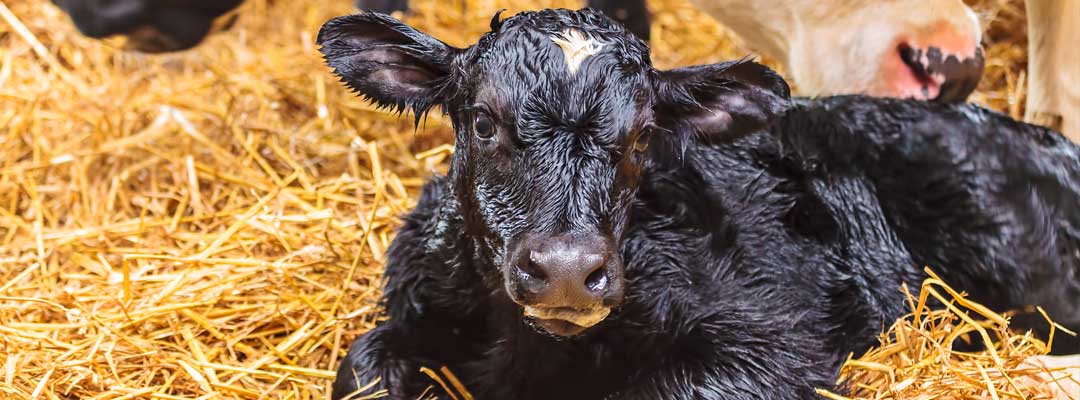6 Best Practices on Safely Pulling a Calf
Cow having trouble calving? Veterinarian details how to pull a calf.

A calf can only be delivered once it is coming the correct way. If you missed it, reference this article which discusses common malpresentations of the calf to allow for safe delivery.
When you are ready to deliver the calf, the first thing you need to do is attach the OB calving chains. If you only put one loop around each leg, there is a high risk of breaking a calf’s leg. To minimize this risk, put the first loop above the fetlock and then put a second loop (a half hitch) between the fetlock and hoof.
Next, you will want to get the elbows engaged in the birth canal. To do this, pull firmly on one leg with an OB handle attached to the chain. You will often feel a “popping” sensation when the elbow enters the cow’s pelvis; you will then want to do this with the other leg. If you are able to get both fetlocks out at least a hand’s width and the head remains engaged in the birth canal, then the calf is able to be delivered. If the head keeps wanting to turn to the side or doesn’t advance when you start pulling, the calf is too big and will need to be delivered via C-section.
Tony Hawkins, DVM, Valley Vet Supply Technical Service Veterinarian, shares six best practices to help you safely pull a calf.
- Employ help; you might need it. Two strong, able-bodied people can physically pull a calf by hand. However, there are many cases in which this may not be possible. In the right hands, mechanical calf pullers can make a wonderful tool. I personally use a calf puller for 95% of my calving assistance because it's easier on my back. I don’t always have the convenience of having another person available to help, and I feel that a calf puller gives me better control.
- Avoid trouble for safe delivery. What can cause trouble to both the cow and calf is when the calf puller is used as a lever, bearing down on it. This causes a tremendous amount of force. I recommend that producers use only the ratcheting mechanism of the puller as much as possible. If it gets tight and you are unable to ratchet any further, then you do need to use it as a lever. To do this safely, when the cow strains, pull the rod of the calf puller down (toward the ground if she is standing, toward her feet if she is lying on her side) firmly but not to your full strength. When the cow stops to rest, move the rod of the calf puller back up and ratchet as many times as you can. Continue this process until the calf is delivered.
- Don’t pull forward-facing calves too fast. I commonly see people try to pull the calf as fast as possible, but if the calves are being delivered forwards, this is not necessary and can actually be detrimental to the calf.
- Offer a little breathing room. It is advisable to release tension on the chains once you get the ribs out to allow the calf moments to breathe.
- Do your best to avoid hip lock. Rotate the calf 90 degrees before you attempt to deliver the hips. This helps align the calf’s hips in an orientation that gives them the most room through the cow’s pelvis. Hip lock is a horrible experience, and I pray that you never run into one. If you do, you need to try to push the calf back in a little ways and get him rotated a quarter turn, then change the direction of your pull either angled toward the cow’s flank or straight down toward her hocks. A lot of lubrication will be your friend. This can take time. Be sure to release tension on the calf and allow him to rest and breathe. After 20 to 30 seconds of pulling, release tension for about 60 seconds.
- Act fast to deliver backward calves. Backward calves are high risk due to the likelihood of asphyxiation or aspiration of fluid. There is not a good test for whether the calf will fit through the birth canal, so it requires a judgment call. You have to pull backward calves fast! The calf will start breathing soon after the umbilical cord gets pinched off (maybe 60 seconds), so you can see why speed is so important. I use a mechanical calf puller for all backwards calves to ensure as fast a delivery as possible.
Pulling a Calf: 6 Best Practices
From the obstetrical examination to delivery takes practice to feel comfortable, so it would be helpful to have an experienced mentor available to help coach you through your first few calving assistances. Do not ever hesitate to contact your veterinarian if you don’t feel comfortable, and remember that if something doesn’t feel quite right, it probably isn’t!
Shop cattle health solutions at ValleyVet.com.



